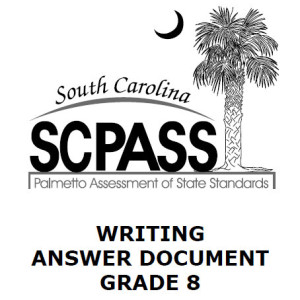 “I’m so sick of the PASS test,” I said to our eighth grade administrator, “and we haven’t even taken it yet.” The test — technically now called the SCPASS, which stands for “South Carolina Palmetto Assessment of State Standards because just “PASS,” as it was called for years, infringed on some copyright or other — is the state assessment for No Child Left Behind (NCLB) compliance. It’s a silly hoop students have to jump through in an effort to provide data about effective teaching, effective schools, and effective students. In theory, anyway. It consists of math, reading, writing, science, and social studies assessments, and the first portion, the writing assessment, rolls around this coming Tuesday.
“I’m so sick of the PASS test,” I said to our eighth grade administrator, “and we haven’t even taken it yet.” The test — technically now called the SCPASS, which stands for “South Carolina Palmetto Assessment of State Standards because just “PASS,” as it was called for years, infringed on some copyright or other — is the state assessment for No Child Left Behind (NCLB) compliance. It’s a silly hoop students have to jump through in an effort to provide data about effective teaching, effective schools, and effective students. In theory, anyway. It consists of math, reading, writing, science, and social studies assessments, and the first portion, the writing assessment, rolls around this coming Tuesday.
Regarding standardized tests, we teachers are always told we shouldn’t be “teaching to the test.” I’m not quite sure what this means, though, because it seems that, given the fact that we have state standards from which we form our curricula and from which test makers derive the tests, any time of standards-based teaching is, to some degree or another, teaching to the test.
This is even more confusing when I consider myself as not just a reading teacher but a writing teacher as well. We teach kids that they should always taken into account their audience and purpose when writing, and so it seems to me we should be doing the same for this test. The purpose is simple: to pass at the very least, with a score of “Exemplary” as students’ ultimate goal. The audience, too, is straightforward: the only people who will read these particular essays are the exam graders. Therefore, as a teacher, I should help students figure out how to write for this purpose to this audience. “It’s jumping through hoops,” I tell them, “not real writing. You’re just trying to show them that you can do all the things on this rubric.”
So we’ve spent the better part of this week and last putting together a plan to write for this purpose to this audience. And I do so in full knowledge that this is not an accurate assessment of authentic writing; it’s an assessment of prescribed writing. Still, except for bloggers, professional writers, and diarists, almost everyone in the “real world” writes primarily prescribed writing: reports, minutes, emails, summaries, proposals, invoices, and the like, so maybe it’s an accurate assessment.
Nah — it’s just hoops.